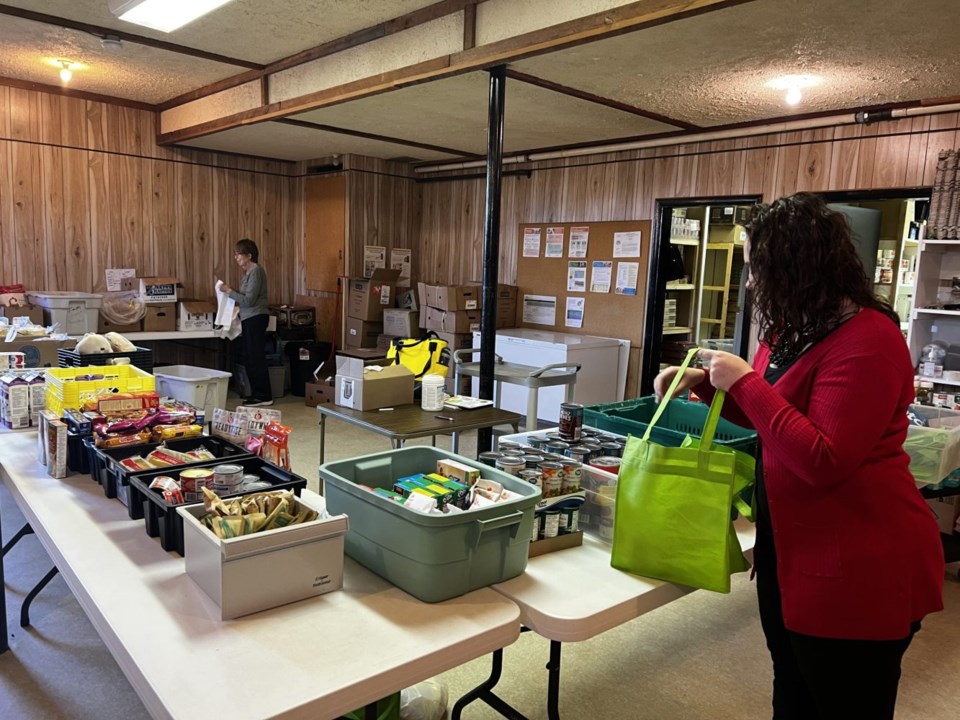Scott Hayes | [email protected]
Local Journalism Initiative Reporter
Demand at the Jasper Food Bank has seen a slow and steady increase over 2023.
The trend, which started with the COVID-19 pandemic, continues onward and upward. Usage before 2020 was around 10 people per week.
In April, the average of weekly client users was in the 60s. By mid-October, that average was up to approximately 90 users.
There was no summer dip either, meaning the typical decrease in demand when people's ability to pay their bills is lower and when they can also decrease their grocery expenses by growing their own food.
Summertime is also typically when people are more flush with cash, said Cristin Murphy, the operations manager at the Jasper Food Bank. Work is more plentiful and bills are lower, although child-care fees go up since children are not in school.
This is a stark contrast to the Banff Food Bank, which does not even operate during the summer. While some of that organization's decision making was based on user demand, some of it also relates to volunteer burnout.
"They said a lot of things compiled together to make that decision ... including volunteer burnout," Murphy said.
"It is really challenging. Everybody can understand why [it's difficult] to get enough volunteers to make it work in the summer."
A lack of volunteers does not seem to be Jasper's problem, however, and is purely a matter of supply and demand.
In late September, the food bank had its high point with 126 users.
"We were at an all-time high and some of our high Tuesday evenings were in September. You have that sense, ‘summer’s over ... the numbers will taper off.’ It hasn't seemed to happen really yet. We'll see how it goes that it now feels like we're in winter."
Since April, more than 3,000 hampers have been provided to residents. People are struggling around the province, as evidenced by Food Banks Canada's recent Poverty Report Card. Alberta received a D, the second-worst rating next to Nova Scotia.
The report indicates that more than 40 per cent of people nationwide feel financially worse off compared to last year, while more than 18 per cent are experiencing food insecurity and nearly 30 per cent are coping with an inadequate standard of living.
"It'll be interesting to see how that looks moving forward for many different places,” Murphy said.
“I think a lot has shifted, and life has gotten more expensive all around, and so more people are struggling."
She also spoke of how the economy is a double-edged sword that increases demand while also making it more difficult for people to buy food to donate to the food bank.
Murphy is grateful for the community's support with individuals and organizations offering as much help as they can. She noted that there is a Pumpkin Path event this Friday that also serves as a food bank fundraiser.
"The last few years have been wildly challenging for all around with the pandemic, climate change ... we've had a lot on our plate. Stress levels are at an all-time high. I think it's hard for an average family with two incomes to make a go of it."
Regarding easing people's stress, Murphy said that Jasper's food bank users should know that while the centre is open on Thursdays from 5:30 to 6:30 p.m., people do not need to line up well in advance to ensure that they receive hampers. The non-judgmental service works by drop-in, so appointments are not necessary.
"We're going to be ready for you. We have food," she said. "We're really trying to figure out a way to do better so that nobody is standing out in the cold because we don't want that to happen."
For those who are coming for the first time, she does recommend that they arrive early, if possible, to fill out the intake form and receive their initial consultation.




